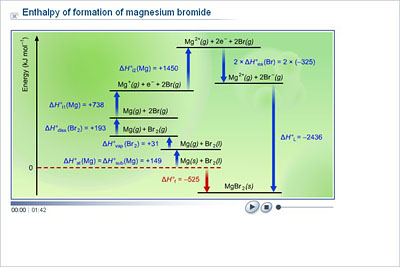

And then finally, what else do we need? Well, we have one potassium solid initially, but at the end, we're gonna need to potassium. So we need to electron affinities, which means this is out. That means that we're gonna need to do to electron affinities. Then they will combine to give me potassium oxide solid realize here that we need oxygen to get a to minus charge. And how many electron affinities E A do you need? Remember, we have to get them into their ionic forms, right? And we need to potassium ions as gas to combine with one oxide ion as a gas. It says when setting up the steps of the born Haber cycle for potassium oxide. But just remember the method we used here to justify how sodium combines with chlorine to give us sodium chloride So, like I told you, the born Haber cycle has a lot of parts to it. Once I get them into their ionic gas form, then I have lattice energy to complete it so he could say that and tilapia formation is composed of these five fundamental steps. Negatives would have to do electron affinity, which also could be more than one step. I'd have to do entropy of dissociation toe break a bond so I could get a single chlorine. Step two would be ionization energy, which could be in more than one step. So I need to do Step one, which is entropy of sublimation. We have to do all of this just to get the entropy of formation. This is connected to lattice energy, so it's a whole process. Now that I have both of them in their ionic forms, they're gonna combine together to give me my solid remember, combining gashes ions to form a solid ionic product. If I had to add more than one electron there will B e a to e a three and so on. Adding an electron is electron affinity, and since I'm only adding one electron, it's e a one. Once we break the bond between the two chlorine, I just have one chlorine now as a gas, and then I have tow. This is called entropy of dissociation here. Next here, I need to separate CL two into two separate Clarence, so I have to break the bond. Remember, we talked about this under successive ionization energies.

If I needed to remove more than one electron, then I'd have to add an organization to organization three and so on. And since I'm only removing one electron, it's ionization energy.

Removing electrons has to do with ionization energy. Once I have it in its gas estate, I need to change it from a neutral metal to a positively charged metal. Going from a solid to a gas is called sublimation, so we're dealing with M. To do that, I first have to convert sodium solid into a gas. What we need to do first is realized that we need to get sodium to its ionic form as a gas and we need to get chlorine to its ionic form as a gas as well. So we're starting out here with sodium solid. Now, in order to calculate the entropy of formation, both elements must first be converted into their ionic gaseous forms. We can have fractions and decimals as coefficients. It's telling me here that the formation of one mole of sodium chloride is accomplished by combining one mole of sodium solid with half a mole of chlorine gas. Standard heat of formation has that little circle there. Now remember, associated with the formation equation is our envelop, or heat of formation, which is Delta H F here. Ah, formation equation shows the standard states of elements combining toe form one mole of product. We're gonna go piece by piece, step by step to figure it out. The born Haber cycle is an extensive process. Now, the born Haber cycle is a reaction outline that gives the steps for the formation of an ionic compound from the standard states of its elements.


 0 kommentar(er)
0 kommentar(er)
